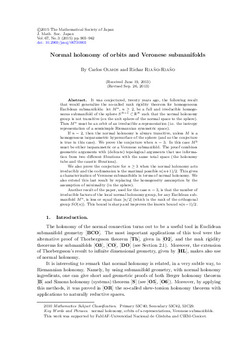| dc.contributor.author | Olmos, Carlos Enrique | |
| dc.contributor.author | Riaño Riaño, Richar Fernando | |
| dc.date.accessioned | 2022-04-05T14:18:31Z | |
| dc.date.available | 2022-04-05T14:18:31Z | |
| dc.date.issued | 2015 | |
| dc.identifier.citation | Olmos, C. E. y Riaño Riaño, R. F. (2015). Normal holonomy of orbits and Veronese submanifolds. Journal of the Mathematical Society of Japan, 67 (3), 903-942. https://doi.org/10.2969/jmsj/06730903 | es |
| dc.identifier.uri | http://hdl.handle.net/11086/23638 | |
| dc.identifier.uri | https://doi.org/10.2969/jmsj/06730903 | |
| dc.description.abstract | It was conjectured, twenty years ago, the following result that would generalize the so-called rank rigidity theorem for homogeneous Euclidean submanifolds: let Mn, n ≥ 2, be a full and irreducible homogeneous submanifold of the sphere SN−1 ⊂ RN such that the normal holonomy group is not transitive (on the unit sphere of the normal space to the sphere). Then Mn must be an orbit of an irreducible s-representation (i.e. the isotropy representation of a semisimple Riemannian symmetric space). If n = 2, then the normal holonomy is always transitive, unless M is a homogeneous isoparametric hypersurface of the sphere (and so the conjecture is true in this case). We prove the conjecture when n = 3. In this case M3 must be either isoparametric or a Veronese submanifold. The proof combines geometric arguments with (delicate) topological arguments that use information from two different fibrations with the same total space (the holonomy tube and the caustic fibrations). We also prove the conjecture for n ≥ 3 when the normal holonomy acts irreducibly and the codimension is the maximal possible n(n+1)/2. This gives a characterization of Veronese submanifolds in terms of normal holonomy. We also extend this last result by replacing the homogeneity assumption by the assumption of minimality (in the sphere). Another result of the paper, used for the case n = 3, is that the number of irreducible factors of the local normal holonomy group, for any Euclidean submanifold Mn, is less or equal than [n/2] (which is the rank of the orthogonal group SO(n)). This bound is sharp and improves the known bound n(n−1)/2. | en |
| dc.format.medium | Electrónico y/o Digital | |
| dc.language.iso | eng | es |
| dc.rights | Attribution-NonCommercial-NoDerivatives 4.0 International | * |
| dc.rights.uri | http://creativecommons.org/licenses/by-nc-nd/4.0/ | * |
| dc.source | eISSN 1881-1167 | |
| dc.subject | Normal holonomy | en |
| dc.subject | Orbits of s-representations | en |
| dc.subject | Veronese submanifolds | en |
| dc.title | Normal holonomy of orbits and Veronese submanifolds | en |
| dc.type | article | es |
| dc.description.version | publishedVersion | es |
| dc.description.fil | Fil: Olmos, Carlos Enrique. Universidad Nacional de Córdoba. Facultad de Matemática, Astronomía y Física; Argentina. | es |
| dc.description.fil | Fil: Riaño Riaño, Richar Fernando. Universidad de los Andes. Facultad de Matemáticas; Colombia. | es |
| dc.journal.city | Tokyo | es |
| dc.journal.country | Japón | es |
| dc.journal.editorial | The Mathematical Society of Japan | en |
| dc.journal.number | 3 | es |
| dc.journal.pagination | 903-942 | es |
| dc.journal.referato | Con referato | |
| dc.journal.title | Journal of the Mathematical Society of Japan | en |
| dc.journal.volume | 67 | es |
| dc.description.field | Matemática Pura | |





